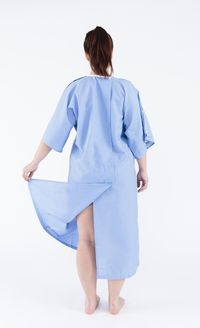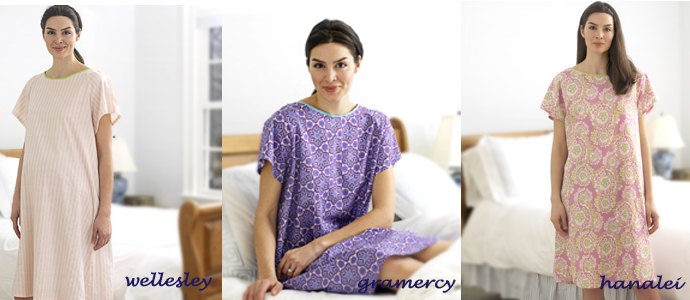Hospital gown
A hospital gown, also known as a patient gown, exam gown, johnny shirt or johnny gown, is a short-sleeved, thigh-length garment worn by patients in hospitals and other medical facilities.
The hospital gown is made of fabric that can withstand repeated laundering in hot water, usually cotton, and is fastened at the back with twill tape ties. Disposable hospital gowns may be made of paper or thin plastic, with paper or plastic ties.
Most doctors, especially in hospitals, find hospital gowns convenient for listening to the heart and lungs. For nurses, giving vaccinations in the buttocks is easier when the patient is wearing a gown rather than street clothing. Hospital gowns are much thinner and looser than regular clothing, so patients are less likely to overheat. Patients wearing gowns are also less likely to be bothered by other clothing issues, such as uncomfortable clothing, having to keep multiple changes of clothing on hand, or removing clothing to use the toilet. The gown is significantly easier and more comfortable to move around in than street clothing.
Hospital gowns are known for not quite closing completely and for being revealing. There have been efforts to modify the gowns to better suit patients by reducing how much a gown reveals of the body; for example, some Muslim women find it embarrassing and shameful to have to reveal their bodies, so in 2004, a Portland, Maine hospital with Muslim patients started providing new, less revealing gowns. And in 2008, x-ray technician Tam Nguyen of Presbyterian Hospital of Allen created larger gowns with velcro closures, for use in mammograms. The gowns are pink, in honor of breast cancer patients.
In 1999, designer Cynthia Rowley created new gowns that were mid-calf length, had a mock turtleneck and three-quarter length sleeves with snaps for women. She also created a gown with drawstring pants, a short sleeve shirt and a matching robe for men. in the same year, Missouri state Representative Sam Gaskill attempted to push a bill that would have required hospitals to provide patients with gowns that would cover the body from the neck to the knee, a bill which never made it out of committee. In 2005 Rachel Zinny created dearjohnnies and the Get Better Hospital Gown, worn by women hospital patients around the world. They are approved by medical staff with snap down sleeves, and come in a variety of patterns all 100% cotton with secure ties and snaps in the back.
Used paper hospital gowns are associated with hospital infections, which could be avoided by proper disposal.
In medical fetish and spanking
Hospital gowns are common in medical fetish scenarios, whether in stories, videos, drawings, photos, or real play. Their attractiveness comes from the fact that they are open at the back, and the "patient" is normally naked under the garment, wearing at most underwear but often not even those. So the garment provides opportunity for embarassment as well as practical easy and quick access to the "patient's" buttocks and anal region -- e.g. for rectal temperature taking, administration of an enema, or examination.
For the same reasons, hospital gowns are also occasionally encountered in spanking stories, videos, drawings, photos, or real play.
| Articles about Gowns |
|---|
| Medical play | |
|---|---|
| People | |
| Locations | |
| Clothing | |
| Medical treatments | |
| Medical equipment | |
| Medical terms | |
| Related things | |
Chat rooms • What links here • Copyright info • Contact information • Category:Root

